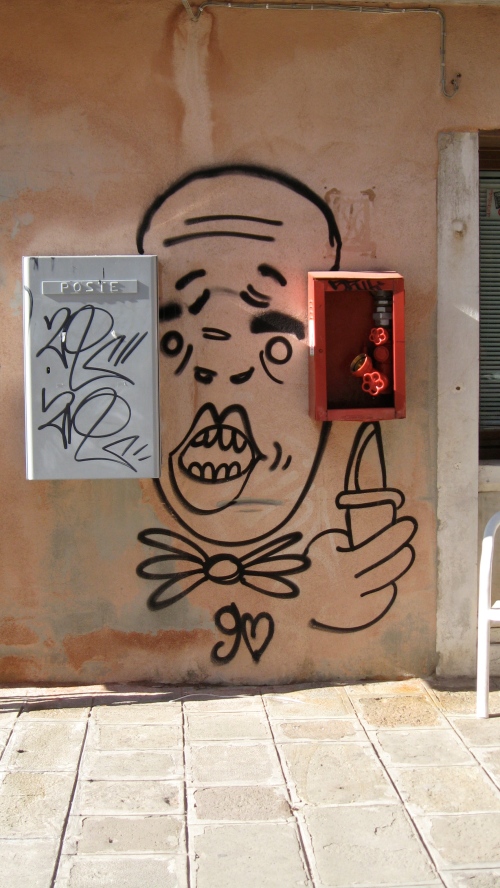
Going to Venice for a long weekend is like being transported to a different realm. In this immersed city, we immersed ourselves in grand-scale Renaissance art, long winding walks, gelato, spritz (Amaro—a bittersweet red liqueur—and prosecco), and seafood. What everyone says about the acoustics stands out as a strong sense memory: without the sound of cars, the ear hears the click of heels on stone, voices talking, murmuring, laughing, and the soft splash of water against stone and brick. True, there are motor boats, but their rumble is nothing after the roar of Roman traffic.
We ate well. Oh, yes we did.
On the first night, we turned the corner from the little alley where we were renting an apartment (with 5 others from the American Academy), and happened upon Paradiso Perdito, a wonderfully unlost paradise of seafood, pasta, off-beat music, and attractive diners and servers both young and old. Here’s a sampling of that meal.

antipasti

vino di casa pump

frito misto

amazingly flavorful garlicky pasta with a never seen before crustacean

squid ink pasta

Jack fell asleep on my lap.


see the rosemary sprig?

nicely boned
Other highlights: The dolci, which we all agreed were better than any in Rome.

how many pistachios are in this torta?
This place especially, which Lisa discovered at 7:30 one morning, by following the aroma of buttery baking, had the most amazing almond croissants we’ve ever had. They weren’t overly sweet and flabby like so many, but were improbably both dense and flaky, and were almost savory in their delicate sweetness.



bread turtle?
I didn’t actually take any photos of anyone eating gelato, because I always had a drippy cone of my own to control, usually with some combination of fruity and nutty. My favorite duo: cherry and hazelnut. Jack’s favorite: strawberry and cherry. But this is the place to get it:

We happened upon this graffito, which to me says, “Is this a gelato I see before me?”

We also saw lots and lots of art. Jack was inspired to do some painting, and then ran off to chase pigeons.

We took one gondola ride, but it only went across the Grand Canal, took two minutes, and cost 50 cents. Still, it seemed to make everyone happy.



Susanna & Stephen

Peter
Our last meal was at the Anice Stellato—the Star Anise—and it was a meal to remember. I wasn’t so good at photographing every plate, but my favorite dish was a lamb tenderloin rolled in crushed pistachios. Oh, my…. The wine, a local carmenere blend, and an antipasto plate called sarde in saor, with sardines, polenta, and pickled onions, also stood out.



Jack enjoyed hanging with the grown-ups. And I think they liked his company too.

Aurelia, Jack, Richard, me
(For more photos, check out my Flickr page.)
Read Full Post »
















 Italy’s Parliament
Italy’s Parliament 






























